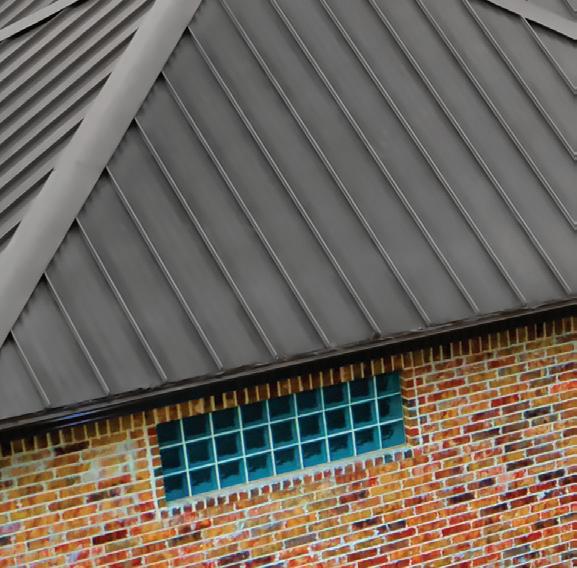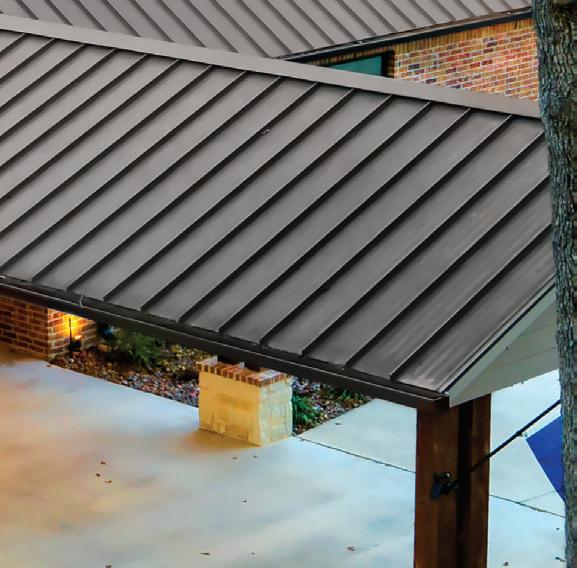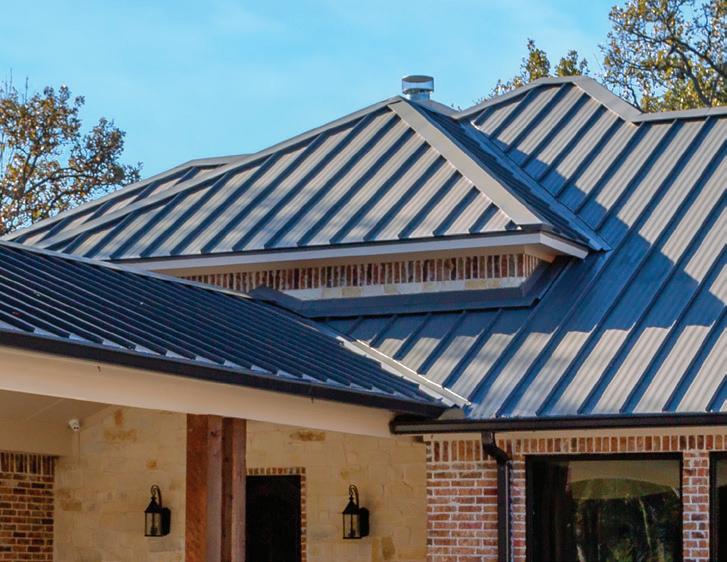











20-acre Gibson farm is full of family history
Page 20







This spring, Louisiana—along with most southeastern states—weathered a series of severe storms. Association of Louisiana Electric Cooperatives, demonstrating its resilience, was able to activate our mutual aid network on a smaller scale to assist our cooperatives with restoration efforts caused by these isolated storms in the southeast. As we enter hurricane season, we stand prepared, fortified by our mutual aid efforts.
Co-ops, united by a spirit of cooperation and community, prepare for major outages and disasters through mutual aid—a collaborative approach to emergency planning. The mutual aid model allows electric co-ops to support each other during times of need. This approach permits co-ops to “borrow” restoration workers from other co-ops, thereby increasing the workforce response to areas impacted by a major outage. It’s essentially about neighbors helping neighbors, even when those neighbors are fellow co-ops located hundreds of miles away.
Electric co-ops operate according to Seven Cooperative Principles. Principles six and seven, Cooperation among
Cooperatives and Concern for the Community, are directly connected to the mutual aid network.
Electric co-ops were formed to provide safe, affordable, reliable electricity to our member-consumers. Being able to restore power efficiently following storms is part of our DNA. During major outages, a variety of equipment is needed to complete repairs, including bucket trucks and other specialized vehicles, utility poles, transformers and wires. Skilled lineworkers, tree trimmers, damage assessors and other key personnel are also often shared among co-ops. These experts provide critical skills and manpower to speed up the restoration process.
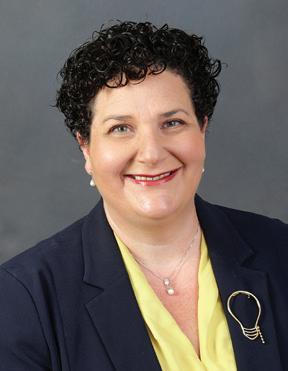
the necessary personnel and equipment, the key ingredients of the mutual aid recipe. These efforts require effective logistics management and experts who fully understand resource allocation and have the know-how to respond under pressure, providing a strong support system for our mutual aid efforts.
ALEC is a nonprofit organization representing the electric distribution cooperatives operating in Louisiana. The Louisiana Electric Cooperatives serve roughly 1 million citizens in 50 parishes. Our mutual aid network, consisting of 26 states working closely with their statewide associations, provides an abundant supply of personnel and equipment when needed most for storm recovery.
Disaster response and mutual aid, crucial aspects of our operations, are managed by electric co-ops and our statewide organizations. These organizations play a vital role in coordination between states, ensuring
CEO Addie Armato
SAFETY COORDINATOR Ricky Melancon
COMMUNICATIONS AND DIGITAL MARKETING
SPECIALIST Conley Bourgeois
ADMINISTRATIVE ASSISTANT Rhianna Garon
CREDIT UNION
Tanya Carroll, manager
Jody Overhultz, representative
President Dennis Glass
Vice President Michael Heinen
Secretary/Treasurer Roger Dale DeHart
Buxton
Marcotte Lane Davidson
Daniel Berthelot Richard “Dickie” Sitman
Michael Heinen Byron Hardee
Trevor Benoit Roger Dale DeHart
Joe Jarrell Dennis Glass Associate



the source of Louisiana’s food traditions Page 12

P.O. Box 4037, Houma, LA 70361
2028 Coteau Road, Hwy. 660, Houma, LA 70364
985-876-6880
Amelia branch office: 2903 Lake Palourde Road Morgan City, LA 70380
985-631-3605 www.sleca.com
STAFF
Matthew Peters | General Manager
Brett Ledet | Assistant General Manager and Manager of Engineering
Shannon Soudelier | Operations Superintendent
Sandi Click | Manager of Finance
Jordy Bourg | Manager of Purchasing
Melissa Bonvillain | Manager of Member Services
BOARD OF DIRECTORS
David Luke | President | 985-855-4106
Roger Dale DeHart | Vice President | 985-860-1078
Larry Daigle | Secretary | 985-870-1121
Terry Trahan | Treasurer | 985-804-7335
Ivan Acosta | 985-397-3341
Trevor Benoit | 985-498-0602
Sandra Boudreaux | 985-464-0064
Abby Rivet LeBlanc | 985-665-6974
Betty Jean Doyle | 985-709-4396
Lloyd Gibson | Board Adviser | 985-209-3765
Louisiana Country (USPS 473-180) is published bimonthly by the Association of Louisiana Electric Co-ops Inc., 10725 Airline Hwy., Baton Rouge, LA 70816, in partnership with Pioneer Utility Resources.
Annual subscriptions: Members $2.30. Nonmembers $5.
Postmaster: Send form 3579 to 10725 Airline Hwy., Baton Rouge, LA 70816.
Periodicals postage paid at Baton Rouge, Louisiana 70821, and additional mailing offices.
It’s that time of the year when the sun is out and temperatures are rising.
While there are many fun things to do in the summer, there are also things you can do to save on energy and your bill. As a valued member of the South Louisiana Electric Cooperative Association, I want to reach out and provide you with some helpful tips on how to conserve electricity while still staying cool during the upcoming summer months.
As we all know, summer usually brings increased electricity use due to air conditioning. However, by following simple energy-saving measures, you can enjoy a comfortable indoor environment without worrying about exorbitant utility bills.
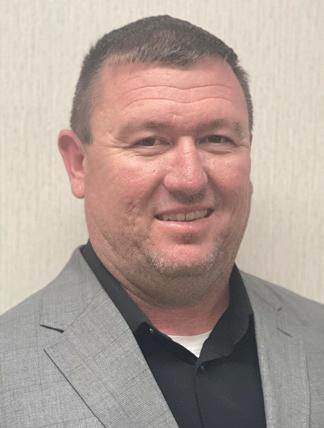
Here are a few suggestions that can help you keep your electric use down:
• Set your thermostat to a moderate temperature. By setting your thermostat to at least 78 degrees, you can achieve a comfortable indoor temperature while minimizing energy consumption. Know that those afternoon showers do play a huge part in cooling off your home.
• Use ceiling fans. Running ceiling fans can help circulate the cool air throughout the room, allowing you to raise your thermostat setting without sacrificing comfort.
• Keep blinds and curtains closed. Closing blinds and curtains during the day can prevent direct sunlight from heating your home, reducing the need for excessive air conditioning. 96003002
• Install weatherstripping around doors and windows. If the weatherstripping is already there, make sure it is in good repair and change if needed.
• Caulk around cracks and openings between door and window frames.
• Unplug any devices or appliances that are unnecessary.
At SLECA, we understand the importance of providing safe and affordable electricity to our members. We care about your well-being and want to ensure you have a great summer while also being mindful of your energy use.
Thank you for your continued support as a valued customer of SLECA. We wish you a pleasant and energy-efficient summer.
Did you know SLECA gives away cash just for reading Louisiana Country In each issue, four account numbers are randomly selected using a computer program and hidden in articles on SLECA’s pages (4, 5, 8, 17, 20 and 21).
If you see your account number, call SLECA and win $25 cash or have the money applied to your bill. If you are not reading Louisiana Country from cover to cover, you’re missing out on great articles and the chance to win money.

SLECA is updating its records for life-support equipment needs and appreciates your cooperation in providing this information.
To maintain quality service or do important work on our electric distribution system, it is sometimes necessary to plan a brief outage to protect the safety of SLECA’s linemen. As members know, preventing outages due to weather conditions or other uncontrollable factors is impossible. Members who require life support should keep their account up to date.
Being on this registry will not prevent service being disconnected for nonpayment. 99272001
To minimize the inconvenience to any member who relies on life-support systems or equipment, we need to know who you are and where you live. We also need to be advised any time changes are made and if the system or equipment is removed.
We appreciate your cooperation in this matter.
If someone in your home is dependent on life-support equipment, fill out this form and mail it to SLECA, P.O. Box 4037, Houma, LA 70361.

Name on account:
Account number:
Name of person(s) on life support:
Phone number: (home) ___________________________________
Type of support system: _______________________________________________________________________
Do you have an emergency standby generator to operate the equipment? Yes ______ No _______

ABOVE: Association of Louisiana Electric Cooperatives staff gather before a busy day.
RIGHT: From left are Dane Hocott, Washington-St. Tammany Electric Cooperative; Randy Pierce, DEMCO; Addie Armato, ALEC; Joe Jarrell, WSTE; Mike Heinen, Jeff Davis Electric Cooperative; Louisiana’s Department of Agriculture and Forestry Commissioner Mike Strain; Matt Peters, South Louisiana Electric Cooperative Association; Johnny Bruhl, WSTE; and Kevin Turner, Beauregard Electric Cooperative Inc.
BELOW: From left, Randy Pierce, DEMCO; Dane Hocott, WSTE; Mike Heinen, JDEC; Matt Peters, SLECA; and Addie Armato, ALEC, meet with Gov. Jeff Landry’s office to discuss cooperative issues.
Association of Louisiana Electric Cooperatives and members hosted the Taste of Louisiana Cookout for elected officials. The afternoon was spent at the Capitol, meeting with legislators and ended with some Louisiana home cooking.






Louisiana electric cooperative leaders met in April with the state’s congressional representatives in Washington, D.C., to discuss topics important to the member-consumers they serve. The visit coincided with the National Rural Electric Cooperative Association’s Legislative Conference, which welcomes co-op grassroots advocates from across the country to the nation’s capital each year.
April 8, 2024
Present were directors David Luke, president; Roger DeHart, vice president; Larry Daigle, secretary; Terry Trahan, treasurer; board members Ivan Acosta, Trevor Benoit, Abby LeBlanc, Betty Jean Doyle and Sandra Boudreaux; and Lloyd Gibson, advisor to the board.
Also attending were Matt Peters, general manager; and Ashley Ferrington, administrative assistant.
The board approved the minutes and the summary of the March 11, 2024, regular board meeting.
The board then approved the ALEC report.
The financial report, approved by the board, highlighted interest earnings, cash on hand, a rate comparison showing South Louisiana Electric Cooperative Association having the most steady rates in the area, line loss, kilowatt-hour sales for the month, cumulative sales to date, cost of service, equity, times interest earned ratio, and electric and total revenue versus cost per kWh. 207960001
Following an update on upcoming schools, meetings and events, Peters reported the following:
• Employee Appreciation Day is an annual event for SLECA employees. It is scheduled for May 18 at the Bayou Black Gym.
• Four payments have been filed under protest letters due to the force majeure with CLECO/Cajun that was due to low river levels. SLECA is still working through the process laid out in the contract for this issue and a similar issue from 2020.
• The NRECA Legislative Conference schedule begins Saturday, April 20, and tentatively ends Wednesday, April 24. Peters is scheduled to attend.
• Youth Tour winners were announced. Winners are Lauren Malbrough and Anthony Plaisance. Marlbrough, daughter of Michael and Bridget Malbrough, attends H.L. Bourgeois High School and is in Doyle’s district. Plaisance, son of Mark and Meagen Plaisance, attends Central Lafourche High School and is in Daigle’s district. 93939001
• SLECA received a check from CoBank for the 2023 patronage capital allocation in the amount of $29,156.64.
• SLECA received two checks from Federal Emergency Management Agency for Hurricane Ida and Hurricane Barry in the amount of $1,009,737.17 in March.
• A total of $151,800,000 has been drawn down from the emergency line of credit. The total amount of FEMA funds received to date is $82,391,784. All of these funds have been applied to the principal of the emergency line of credit with Cooperative Finance Corporation.
The board approved the transfer of SLECA assets to 1803. This will allow the ability to move high-voltage switches and transmission breakers that are currently SLECA’s responsibility to the 1803 who will maintain these assets.
The board approved the renewal of the CFC line of credit.
The board approved the manager’s report, attorney’s fees and safety report showing employees have worked 4,532,746 hours without a lost-time accident since December 1996.
The meeting was adjourned.




By Cheré Coen
When her pan-seared red drum over tomato polenta with a crawfish cream sauce earned Amanda Cusey the 2022 Louisiana Seafood Queen title, many people likely thought the Lake Charles chef was a Bayou State native. However, Amanda’s life and career have taken her around the world, landing her in Louisiana only because her parents found work in the Lake Charles area.
“Butter makes everything better.”
“Don’t be afraid to try something new, and don’t be afraid to fail. And don’t be afraid to be weird.”


“Don’t overcook seafood. Seafood can be very delicate. If undercooked, you can always bring it back up.”

Originally from Flagstaff, Arizona, Amanda was living in North Carolina when her parents, both Chicago natives, encouraged her to join them in England, where they lived at the time. She accepted their offer and attended Cordon Bleu training at Tante Marie Culinary Academy in Surrey.
Amanda later worked in English gastropubs, an American diner in Ireland, and under chefs Kristan Burness and Brendan Ward at Fiorentina in Dublin, where she ultimately earned the head chef position. She worked briefly with Michelin star chef Oliver Dunne at his Italian-inspired pop-up restaurant, Eatily, in Dublin’s city center. When Amanda’s parents grew tired of cold English winters, they began planning their return to the States. An engineering job brought them to Lake Charles, and Amanda followed. At first, the Southwest Louisiana town took some getting used to, but the hospitality Acadiana is known for quickly won her over.


























































“It’s quite grown on me,” Amanda says.
She first developed traditional Italian dishes inspired by her years in Europe to mix with Louisiana influences at The Villa in downtown Lake Charles. Now, she helms the kitchen at The Terrace restaurant at Lake Charles’ Family Entertainment Center, melding her European training with local dishes, flavors and ingredients.
The casual restaurant allows Amanda to bring her elevated cuisine to the masses. Dishes include shrimp and grits, fried blue oyster mushrooms with house-made garlic aioli, flatbreads, and fried shrimp coated in Bayou Satsuma Rum and toasted coconut.
In addition to her seafood title, Amanda was also awarded the title of Best Chef in Lagniappe magazine’s Best of SWLA awards, which was voted on by readers. She is the second woman to earn this recognition and the first Lake Charles chef.
She also headed to Charlotte, North Carolina, with chef Lyle Broussard of L’auberge Casino Resort of Lake Charles in 2023 to be paired with North Carolina chefs in a restaurant takeover experience.
The accolades have been “surreal, a really cool experience,” Amanda says.
Seeing Lake Charles’ culinary scene grow during the past eight years has also been rewarding.
“It’s been cool to watch,” she says. “The city’s definitely got a whole lot going on.”



















½ cup red peppers, diced
½ cup shallots, finely diced
1 pound Louisiana lump crabmeat, cleaned
1-2 lemons, depending on size, zested and juiced
¼ cup parsley, chopped
2 tablespoons garlic, freshly minced
2 teaspoons Cajun seasoning
1 cup panko breadcrumbs
¼ pound butter, melted
Salt and pepper, to taste
2 tablespoons oil
Saute the peppers and shallots until just tender. Add to a mixing bowl and combine with the rest of the ingredients. Adjust seasoning as needed. Cover and refrigerate for about an hour. Remove from fridge and form cakes to your desired size. Heat the oil and pan sear each side of the cakes until golden brown. If you made large cakes, you may need to pop them in the oven to heat them completely through.








































































































By Cheré Coen




























Louisiana is rich in culinary traditions, but how often do you consider where some of the tastiest ingredients originated? It’s even less common for people to experience these rich agricultural traditions firsthand. Fortunately, there are many opportunities throughout the state for folks to delve deeper into our food sources.






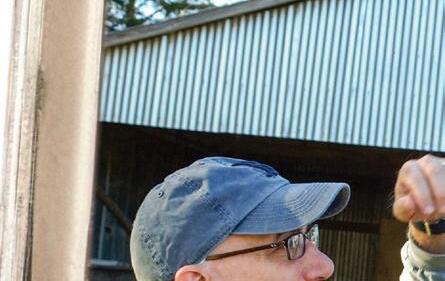












In the growing segment of the travel industry known as agritourism, participating businesses offer visitors a chance to immerse themselves in the agrarian way of life—whether milling rice, trapping crawfish or making hot sauces. From charming family-owned farms that offer accommodations to you-pick farms, destinations across Louisiana invite travelers to experience the rhythm of rural life, savor farm-fresh produce and engage in hands-on activities that celebrate the region’s agricultural traditions.





Breaux Bridge is a short drive from Lafayette, but Bonne Terre Farm feels like another world. This tranquil 10-acre working farm offers two quaint residences to choose from for an overnight stay. Guests can lounge in accommodations stocked with locally made amenities such as soap, fresh eggs, condiments and artwork. Owner Jennifer Gray is a Louisiana ambassador who loves sharing the state’s cultural offerings, and she often takes her guests on guided walking tours of the farm.


Jennifer loves her animal friends, and it shows. Visitors who stay at Bonne Terre don’t have to tour the farm, but Jennifer is happy to introduce them to her turkeys, horse, cow, geese and other friendly


























critters. On a scheduled tour, she expresses her appreciation of animals and the environment, believing immersion in a natural setting might be just the cure for many of modern life’s ills.








information, call 985-241-0910 or visit the farm’s Facebook page.

“It is a beautiful thing,” she says. “Animal therapy is a true science, and people benefit from it.”
Bonne Terre Farm, French for “good earth,” is for adults only. For more information, visit bonneterrelouisiana.com.


Other farm stays: Splendor Farms in Bush offers guest accommodations along with horseback trail riding, riding lessons and a petting farm. For more information, visit splendorfarms.com.



SonLight Farms in Bogalusa lets visitors pick their own blueberries or, if you’re feeling less hands-on, you can buy the fruit pre-picked and packaged. The family-owned and operated farm grows blueberries without chemicals. Be sure to call ahead,
Other berry-picking farms: Landry-Poche Farms in Springfield offers field trips for students and parents in the spring and an annual Family Fun Day. For more information, visit landrypochefarms.weebly.com.






Bachman Blueberries in Bush supplies a bucket, and you pick the berries. The season ends midsummer. Be sure to wear closedtoe shoes and bring water, bug spray and sunscreen. Visit the Bachman's Facebook page for updates.


Just north of Kaplan, Barry Toups takes visitors and residents out to his crawfish ponds, where he explains the business of raising Louisiana’s favorite crustacean. After the tour, visitors can enjoy their caught bounty boiled and served.
Barry is the proprietor of the circa-1903 Crawfish Haven/Mrs. Rose’s Bed and Breakfast, which offers three guest rooms. His tours put visitors in boats puttering through his ponds to retrieve what will be their supper. He fits six people in a boat at a time and pulls up 50 to 100 traps. Afterward, he boils the crawfish and serves up 5 pounds per person.


“We explain all about the life of the crawfish,” Barry says. “It’s very educational. The whole process is two to three hours, depending on how many questions they have.”











































Barry’s crawfish excursions run December 1 through midMay or June 1, depending on that year’s crop. This year was more sparse than usual due to last summer’s drought. He speaks French, so many of his clients hail from across the Atlantic.






Barry’s tours have become so popular, he’s been on many television shows and in The New York Times Magazine. For more information, visit www.crawfishhaven.net.
Other crawfish tours: Jeff Davis Parish Tourism offers crawfish tours that take visitors from the boat to the processing plants. For more information and to book a tour, visit jeffdavis.org/tourism.









Team Voodoo Crawfish Tour is offered near Breaux Bridge. For information, visit www.crawfishtours.com.
Tabasco


The same pepper sauce recipe used by Edmund McIlhenny back in the mid-1800s is still used today at Tabasco’s factory on Avery Island outside of New Iberia. Visitors to the factory get to watch the blend of Tabasco peppers, salt mined from Avery Island and high-quality distilled vinegar aged in white oak barrels create one of the world’s most recognizable brands.



transmission. Attendees see much of the mill’s original equipment, view a slide presentation of Acadian history and browse the Konriko Co. Store that sells cookbooks, crafts, Cajun music and local food products, including Konriko rice fresh off the mill.













Tours are offered on the hour between 10 a.m. and 3 p.m., Mondays through Saturdays. Learn more at www.conradrice.com.

“It’s remarkably interesting for a short tour,” says New Iberia author Lynn Shurr, who brings visiting guests there. “There is also a good movie beforehand, free samples of coffee and food in the store and the best assortment of souvenirs in the entire town.”
Visitors also learn about Tabasco history and artifacts, view the pepper-growing process, get a look at the aging process in the mash warehouse and sniff from the vats where the magic happens. The factory compound also includes a restaurant and gift shop.
For information on the self-guided tours, visit www.tabasco.com.



New Iberia is home to America’s oldest operating rice mill, and a tour shows visitors how rice milling came about.
Conrad Rice Mill was built in 1912 and is an example of the factory’s use of a turn-of-the-century belt-driven power





There’s a stretch of northwest Louisiana where sunflowers grow tall and wide. Folks in this region honor this bright, sunny flower every June with the annual Sunflower Trail and Festival in Gilliam, but visitors can enjoy the bright yellow blooms throughout the summer by driving the Sunflower Trail.
This scenic drive along Route 3049 and Sentell Road, south of Belcher, features a sunflower maze, wildflower fields, zinnia blossoms and historic stops, including the Veterans Memorial in Belcher, Crossroad Museum in Gilliam, Northrose Plantation in Dixie and more. Sunflowers along the trail are in full bloom and are expected to last through July.










ALEXANDRIA
Alexandria Farmers Market


Crescent City Farmers Market







3-6 p.m. Tuesdays, 2727 Jackson St.
LAKE CHARLES
Charlestown Farmers Market
8 a.m.-noon Saturdays, 1001 Ryan St.
Cash & Carry Farmers Market
4-6 p.m. Tuesdays, 801 Enterprise Blvd.
SHREVEPORT


Shreveport Farmers Market
7:30 a.m.-12:30 p.m. Saturdays, through Aug. 24, Festival Plaza, 101 Crockett St.
St. Francisville Farmers Market
8 a.m.-noon Saturdays, barn at 9961 Wilcox St.


New Orleans markets are held weekly at City Park, Uptown Square and Mid-City. Details are online at www.crescentcityfarmersmarket.org.
Red Stick Farmers Market


Year-round markets are Thursdays: 8 a.m.-noon, Pennington Biomedical Center, 6400 Perkins Road; Saturdays: 8 a.m.-noon, North Fifth and Main streets, downtown Baton Rouge. Seasonal markets are 3-6 p.m. Tuesdays at the East Baton Rouge Parish Library, 7711 Goodwood Blvd; and 9 a.m.noon Wednesdays at the Exxon Mobile YMCA, 7717 Howell Blvd.





Natchitoches Farmers Market




8 a.m.-noon Saturdays, through July 27, 100 Rue Beauport
Houma’s Market at the Marina
8 a.m.-noon, first Saturday of the month, downtown Houma Marina
LAFAYETTE





Lafayette Farmers & Artisans Market
8 a.m.-noon Saturdays, Moncus Park























Saturdays through August




















Weatherizing your home provides energy savings and comfort yearround, especially during summer months when your air conditioner is working overtime.
A home with insufficient insulation and air leaks wastes more than 20% of the energy used to heat or cool the home, according to energystar.gov. Fortunately, most weatherization projects are DIY and can be completed in a day.
The simplest and most cost-effective weatherization strategies include air sealing around windows and exterior doors.
If you have older windows, odds are you have air escaping through cracks and gaps around the frame. If you can see daylight around the frame or if the windows rattle easily, you likely have air leaks. Also check for small cracks around the frame that may not be visible with sunlight.
If you suspect you have leaky windows and plan to apply new caulk, be sure to remove the old caulk and clean the area before application. Caulking materials vary in strength and properties, but you’ll likely need a half-cartridge per window.
Silicone caulk is a popular choice and can also be used to seal joints between bathroom and kitchen fixtures.
Another effective but simple weatherization project is installing weatherstripping around exterior doors. The most common types of
weatherstripping options are V-channel, felt and foam tape. Choose the best for your home by considering temperature fluctuations and weather exposure. Most homeowners opt for felt or foam tape; both are easy to install but need to be replaced every couple of years, depending on wear and tear. Weatherstripping should be installed around the top and sides of the door.
If you see daylight around the bottom of an exterior door, consider installing a door sweep in addition to weatherstripping.
Weatherstripping can also be installed around windows. Another way to improve comfort in your home is with insulation. While this is a more costly project and requires a professional’s help, it’s an effective way to decrease heat flow.
Older homes may need additional insulation to replace older materials or meet newer efficiency standards. Contact a qualified installation specialist if you suspect insulation levels are inadequate.
The best way to identify air leaks in your home is a blower door test. A blower door test helps determine how airtight your home is and identify air leaks.
In addition to saving energy, air sealing can help avoid moisture control issues, improve indoor air quality and extend the life of your heating and cooling system. Weatherize your home to unlock yearround comfort and savings on monthly energy costs. n


Abby LeBlanc is a native to Gheens. She was elected to the board in April 2024. She follows in the footsteps of her late father, Brian Rivet. Abby has grown up in the South Louisiana Electric Cooperative Association family and has witnessed firsthand most of her father’s 39-year commitment as a board member. She is passionate about her community and excited to pick up the SLECA torch from her father.
Abby is married to Jared LeBlanc and has two daughters. In their spare time, they run a quality cow/calf operation. She is a board member of the local cattlemen’s association, carnival club and is active in Lafourche 4-H.
Abby has been a full-time employee at Lafourche Animal Hospital for 20 years and is ready to be a voice for her community and learn how best to serve.

Sandra Boudreaux is a native of Chackbay and resident of Donner. She was elected to the board in April 2024. She serves the same district as her late husband Julian “JD” Boudreaux III.
Sandra holds bachelor's and master's degrees in education and +30 in guidance and counseling from Nicholls State University. She taught school in Terrebonne Parish for 31 years. Sandra is a former CCD teacher for St. Lawrence Church, receiving the Bishop’s Medal in 1987. Currently, Sandra is a member of TRTA, LRTA, and Louisiana Volunteers for Family and Community.
The mother of J. Dennis Boudreaux IV and Lisa B. Links, Sandra is also an artist and enjoys photography, gardening, sewing, reading and traveling.

Bayou Blue native Larry Daigle has been a SLECA member since 1965 and was elected to the board in April 2004.
He served 39 years as senior vice president of Caro Produce and nine years as president of Prime Source and Southland Distribution. Larry recently retired as the local produce buyer and grower liaison for Rouse's Supermarket.
He serves on the finance committee and parish council for St. Louis Catholic Church. Larry serves as a board member for the Terrebonne Parish Council on Aging and has served as advisor to Bishop Boudreaux on the Pastoral Council. He received the Bishop's Award in 1988 for outstanding service to the parish.
Larry attributes the success of his commitments to his wife of 61 years, Ruby Levron Daigle.
South Louisiana Electric Cooperative Association held its 86th Annual Membership Meeting on April 12 at the Barry P. Bonvillain Civic Center in Houma. The meeting was called to order at 7 p.m. by General Manager Matthew Peters. Roughly 1,500 people attended the meeting.
Matthew addressed the highs and lows throughout the year and thanked members for their patience and understanding.
He also addressed SLECA’s wholesale power contract expiring the first quarter of 2025. Once the new contract takes effect, members can expect to see a decrease in their monthly electric bill.
Entertainment for the meeting was provided by the Houma Terrebonne Community Band. SLECA Director Trevor Benoit performed the national anthem, Rochelle Glispy performed a patriotic tribute and the Central Lafourche High School JROTC presented the colors.
SLECA’s 2024 Washington, D.C., Youth Tour winners and 2024-25 scholarship winners were recognized and presented with certificates.
The evening concluded with drawings of 50 door prizes, including 10 $100 electric bill credits and two 55-inch flat screen smart TVs.
We would like to thank all our members and their guests for coming out to the 2024 annual meeting. We can’t wait to see you again next year.

LLC

Proud to serve
Beauregard, Claiborne, Concordia, Jefferson Davis, Northeast, Pointe Coupee, SLECA, SLEMCO and Washington-St Tammany electric cooperatives






























In today’s digital age, utility scams are on the rise, targeting consumers of water, gas and electricity. Scammers are becoming more sophisticated, exploiting technology to deceive people through various means, such as phone calls, texts, emails and deceptive websites.
Here’s what you need to know to protect yourself:
Recent scams include imposters posing as utility representatives, demanding immediate payment to avoid service disconnection. They may also claim you’ve overpaid and offer a refund in exchange for personal information.
Spotting a scam involves watching for high-pressure tactics, unusual payment requests—such as gift cards or cryptocurrency—and signs of poor communication quality, such
as misspellings and incorrect grammar.
Do not make instant payments or share personal information over the phone or via email. Your co-op provides secure payment options and never demands immediate payment or requests sensitive details via these channels.
If you’re unsure about a communication claiming to be from your co-op, hang up and call the office directly to verify.
To avoid scams, be cautious of unknown individuals requesting personal information, and report any suspicious activity.
By staying vigilant and communicating with your utility provider, you can help protect yourself and your community from fraud. n


By EmmaLee Tingle
Tim Domangue grew up around alligators, and he has built a full-time agriculture and agritourism hot spot east of Morgan City called Greenwood Gator Farm and Tours.
The 20-acre farm in Gibson is full of family history. Tim’s dad, Richard, created a successful business buying alligators from gator hunters to sell the gator meat and hide to various buyers.
In 1986, Richard was approached by the Louisiana Department of Wildlife and Fisheries about alligator farming, which was then called Greenwood Gator Farm.
In 2003, Tim bought the business from his dad. He began buying alligators from hunters and processing them on-site. When processed, alligator skin is sold for high-end fashion projects in places such as Italy and France. The meat is also processed and shipped throughout the United States.
To increase production, Tim routinely collects alligator eggs from the nests in the marsh. He goes out on an airboat to locate nests of eggs and collects them for the farm. Collecting eggs from the wild increases the hatch rate, Tim says. In the wild, only 20-30% of alligator eggs hatch without the eggs or baby alligators being eaten by a predator. At the farm, in the safety of the incubator, 80-90% of the alligator eggs hatch.
Tim says he’s never been in a situation where he’s been scared to collect the eggs.
“The biggest element we face is actually mounds of fire ants on the nests,” he says.
The collected eggs are incubated at the farm’s hatchery. Baby alligators are then placed in grow-out pens to grow for about a year. From there, they are harvested and moved to the processing plant. The desired size of an alligator for processing is between 3 and 4 feet long. Alligators typically reach this size at around 1 year old.
At any point, there are usually 10,000-12,000 alligators on the property in different stages of growth. Hatched alligators are housed in enclosed pens. Pens are typically 40 feet by 70 feet, and each with multiple stalls. Each stall holds 50-70 alligators.
Although Tim raises his own alligators and buys gators from





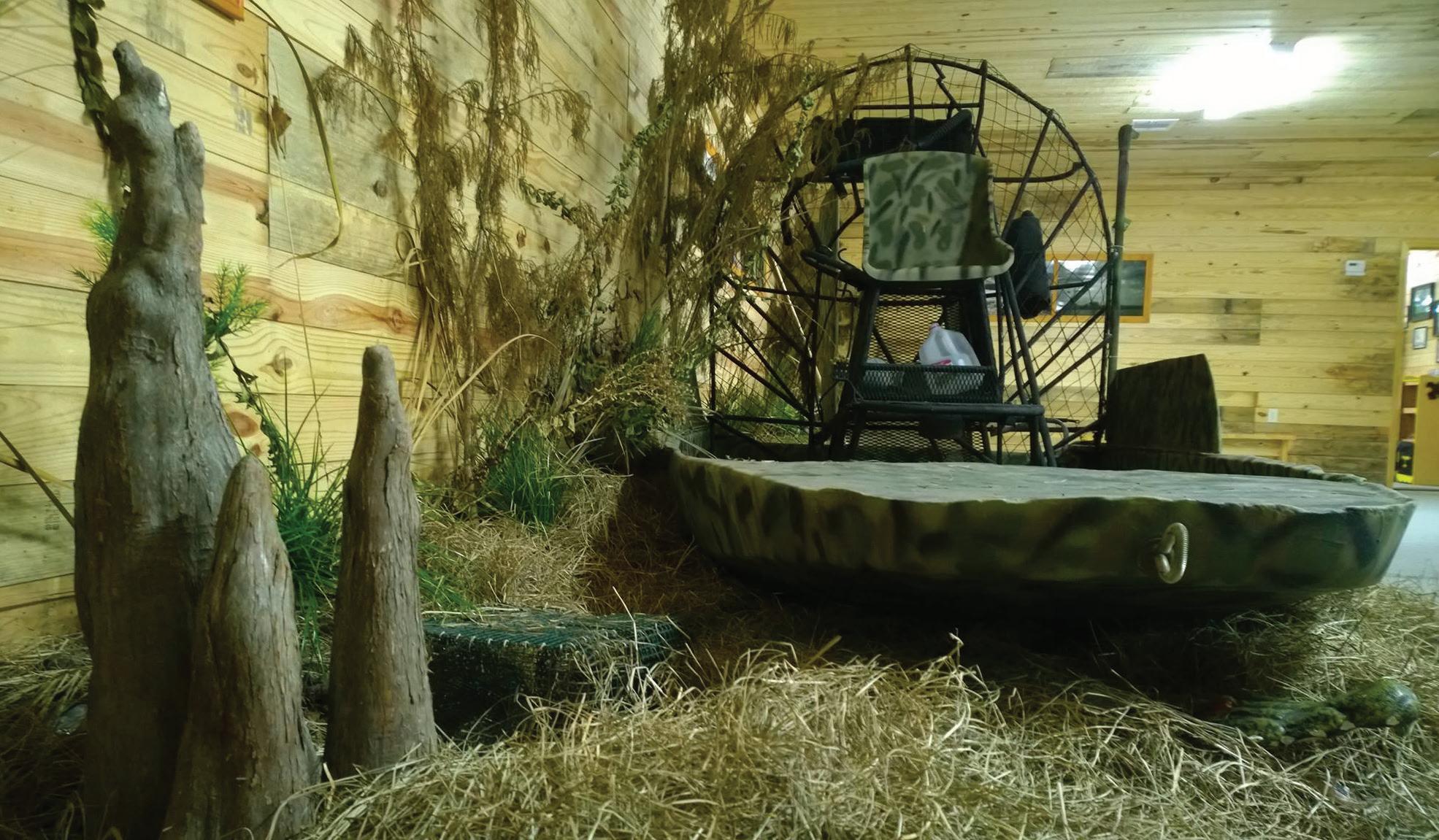
Tim Domangue routinely takes the airboat to locate alligator nests and collects the eggs for the Greenwood Gator Farm. LEFT: The farm houses tens of thousands of alligators on the property.
eggs lay in their incubators.
hunters, he says farm-raised alligator hide is of higher quality and value. Alligator hide from the wild often has blemishes and scars from fighting other alligators, having altercations with other predators or being hit by a boat in the marsh.
Tim’s alligator farming business ran smoothly until the economic downturn drastically affected farm operations in 2009.
“We couldn’t sell product,” he says. “We didn’t pick up eggs. We couldn’t sell overseas. We had no income.”
That hardship on the farm caused Tim and his wife, Paula, to step back and look for additional revenue streams. Paula, a registered nurse by trade, is a co-owner and works in every area of the farm when she’s not in her role as a nurse.
In 2009, Tim said he began allowing farm visits where guests could hold a baby alligator for $5.
In 2010, he began offering covered wagon tours of the property. On these tours, he takes visitors to the hatchery, grow-out pens and the processing facility. That’s when the farm became Greenwood Gator Farm and Tours.
Tourism on the farm had outgrown the wagon tours by 2011,
and Tim knew he needed to build a new space for tourists. The farm now boasts a tourist building, gift shop and covered area for large group gatherings.
Today, Greenwood Gator Farm and Tours hosts field trips, birthday parties, business meetings, family reunions and other large gatherings.
Tim installed a large playground, an alligator-shaped bounce house, and many penned land animals for tourists to pet and feed. The gift shop also sells marshmallows—a favorite treat among the alligators.
“I always heard that if you build something for kids, parents will follow,” he says.
The result has been a successful agriculture and agritourism business in the heart of South Louisiana Electric Cooperative Association’s service territory.
Greenwood Gator Farm and Tours is located at 125 Gator Court in Gibson. For more information, call 985-804-0744 or visit www.greenwoodgatorfarmtours.com. Anyone can follow the fun on the farm’s Facebook page.
Have you ever watched a video or TV show where a person is cooking a meal, then suddenly they snap their fingers and the meal is plated and ready to eat? That’s called a jump cut. While everyone wishes we could “jump cut” from a power outage to power restoration, it often takes a lot more effort and people to make it happen.
It’s natural for members to have questions about power outages and why it can take time to get the lights back on. Given our reliance on electricity, there’s simply never a good time to be without it.
Here’s a behind-the-scenes look at the restoration process to help members understand what may be happening when the power is out.
1. 2. 3.
We rely on you to let us know if your power is out. When your power goes out, it might be just at your home or a small section of your neighborhood. There is a chance your cooperative may not know about it, and no one has reported it.
When you’re without power, co-op employees might be, too. Because we are local electric cooperatives owned by the members we serve, employees are local. They are your neighbors, friends and familiar community volunteers. It’s a team effort. Every co-op employee works to get power restored as soon as possible. Member service representatives take your calls, engineers and field staff survey damage, the vegetation management team clears hazards, dispatchers organize crews, and communicators keep everyone informed of progress or potential dangers. When the power goes out, everyone on the team works together as quickly and safely as possible to restore it.
4. 5. 6. 7. 8.
Assess the situation. Every outage is different, and in the very beginning it’s hard to know how dangerous it is or whether equipment might need to be replaced. When responding to outages, the first step is to see what happened, then figure out which materials are needed and then create a plan for how to fix the problem(s) without compromising electric flow for the rest of the members. Restoration is normally prioritized by the largest number of members that can get back on in the shortest amount of time. Crews focus on responding first to public safety issues and critical services such as hospitals. Then work is completed that impacts the largest number of people first.
Co-op employees face many dangers. Besides working around high-voltage electricity, crews are on alert for wild animals, weather elements, falling trees and fast-moving cars. If you ever drive past a utility vehicle, please do so slowly.
Flickering lights are a good thing. Some folks mistake flickering lights for outages, but these “blinks” are important because they indicate the equipment worked and prevented a possible outage likely caused by wayward animals or stray tree limbs on the lines. You need a backup plan. If you depend on electricity for life support purposes, you must have a backup plan. Remember, it’s not always known how long restoration efforts will take.
9.
Employees have to plan and eat. If you ever see co-op trucks in a restaurant parking lot while your power is out, know that sometimes employees huddle in a safe, common area to map out the strategy for getting the power back on. Also, crews work long, hard hours during outages and need to take time for meals, just like everyone else.
10.
Sometimes it’s a waiting game. Each portion of the power grid is connected to other electric utilities, and positive relationships are maintained with power providers interconnected to our system. If an outage is due to an issue from their feed into the system, they must repair it.
Periodic power disruptions are inevitable. If the lights go out, know your co-op team is working as quickly and safely as possible to restore power.
There is never a good time for the power to go out, but if it happens on a sunny day, you might be left wondering why. Here are the most common causes of a power outage.
Scheduled
High winds, snow and ice can cause tree limbs to fall on power lines. Other weather effects, like wildfires and lightning strikes, can cause major damage to equipment.
Squirrels, birds, snakes and other animals can inadvertently contact power lines, causing short circuits and disruptions to electrical supply.
Occasionally, we plan outages to perform upgrades or repairs to parts of the local grid.
Vehicles can crash into utility poles, bringing down power lines. Construction and excavation work can also result in disruptions to underground lines.

